Our usual lunch is Bi Bim Bap – which is Korean for “leftovers.” (Literally, it means “mixed with rice.”)
Bi Bim Bap is a versatile dish which can be assembled out of almost any combination of ingredients. Like Cambridge Fried Rice, it is a classic Asian method for combining leftovers to create a meal in a bowl.
The Bi Bim Bap Recipe
The best place to look for a formula for Bi Bim Bap may be the Perfect Health Diet Food Plate:
The body of the apple contains our formula for a meal. Great meals combine four kinds of ingredients:
- A safe starch.
- Meat, fish, and eggs.
- Vegetables, herbs, and spices.
- A sauce made from fats and acids.
Our Version of Korean Bi Bim Bap
The classic Korean Bibimbap recipe uses barbecued beef and eggs as the meat, rice as the starch, mixed vegetables, and a Korean spicy sauce with sweet and sour flavors.
We assembled the following ingredients as an example. For meat we used meatballs and slices of leftover ribeye:
We also included eggs as a second kind of meat. As a base for the sauce we used Korean spicy sauce; here is a possible brand: Sunchang Gochujang 500g. Which is not perfect, as it contains
soybean powderwheat, but as it’s quite spicy a little goes a long way. Chili flakes can substitute for the Korean sauce.
Koreans usually favor a mix of spicy, sweet, and sour flavors in the sauce. The sweet and sour can be provided by equal parts rice syrup and rice vinegar, plus a splash of sesame oil and salt and pepper:
The spicy sauce paste is mixed with this sweet and sour mixture to make the sauce. One tablespoon spicy sauce, 1 tablespoon rice syrup, and 1 tablespoon rice vinegar or lemon juice will make a good sauce. For children, increase the sweet and sour flavors and decrease the spicy/chili flavors.
For acids, lemon juice or lime juice, or some other flavor of vinegar, can be substituted for the rice vinegar.
For more spiciness, bits of jalapeno can be added. Egg yolk can provide an additional source of fat.
Include vegetables of your choice. These are onions, peppers, green bean, and watercress:
Kimchi (fermented vegetables) can be substituted for the vegetables.
Everyone can make his own bowl. Since we’ve just been debating how much of the “safe starches” one should eat, here’s what we consider a full meal’s worth of rice:
This is 150 g of cooked white rice which works out to about 200 calories of carbs. We eat two meals a day so this works out to about 400 carb calories per day.
On top of the rice Paul has added meat, vegetables, egg, egg yolk, spicy sauce, and lemon juice:
A bit of rice syrup and a little more meat got the proportions to Paul’s liking.
Here was Shou-Ching’s bowl:
Just mix all the ingredients together and eat!
Bi Bim Bap at Lunch
We didn’t take pictures, but Paul’s typical lunch is assembled like this:
- Whatever leftover safe starch is available is put at the bottom of the bowl. If this is potato or taro, Paul dices it up into small pieces; if it is rice it looks rather like the picture above.
- Paul adds 3 egg yolks and the juice of half or quarter lemon.
- Paul adds leftover meat and vegetables.
- Paul adds spices to taste. These may include spices with medicinal value, such as turmeric, and then curry or other spicy flavors. Or they may include salt and pepper, or rice syrup for a sweet flavor.
- The Bi Bim Bap is microwaved for a minute, then mixed and microwaved again until it is uniformly warm.
At dinner we usually cook at least twice as much as we intend to eat that night, so there are plenty of leftovers. The leftovers provide lunch and usually a Bi Bim Bap, Cambridge Fried Rice, or Japanese sushi buffet dinner of leftovers once during the week.








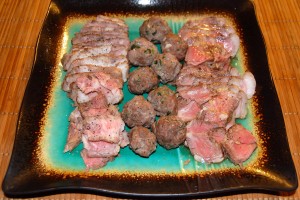
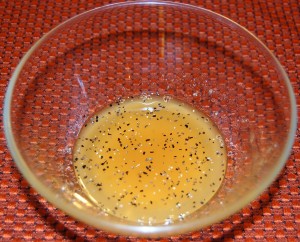
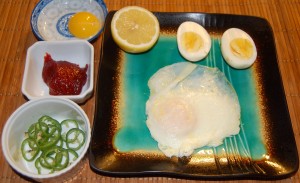
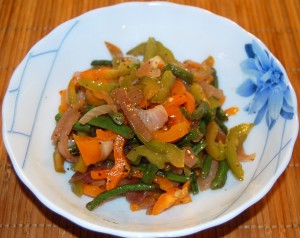
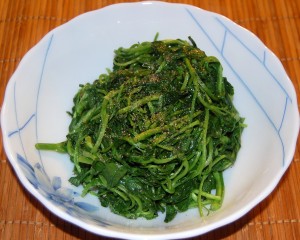
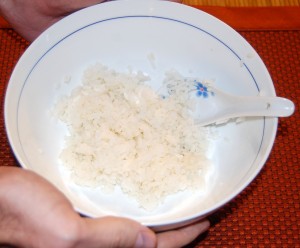
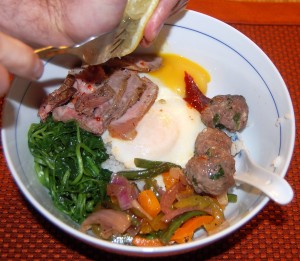
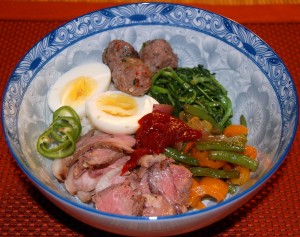




I have been eating Bi Bim Bap ever since Paul mentioned it in the Chris Kresser Podcast and have come to learn that sometimes there is nothing more satisfying than a bowl of rice topped with raw egg yolks, meat, and assorted veggies!
I actually usually make mine with the Pacific Sweet & Sour sauce recipe you guys gave awhile back, and the featured meat is usually liver.
I have never been much of a cook, but these quick, easy recipes have really helped liven things up!
I love Bi Bim Bap! My favorite is to have it with barbecued pork and topped with a runny-yolked egg.
But Bi Bim Bap’s pretty easy to make PHD-approved. But what about patbingsu? It’s lovely during the summer but I’m pretty sure it would take some tinkering to healthify it.
Thanks for posting this great recipe for bibimbap, Paul! (I guess I, too, first became aware of you and bibimbap through the Chris Kresser program.) I have to ask: when we read “Paul adds 3 egg yolks and the juice of half or quarter lemon.”, you are referring to 3 RAW egg yolks? And then, if that’s true, I have to ask, when you eat raw eggs, do you always discard the whites? (I read that they contain a substantial anti-nutrient recently, but don’t necessarily know that that is considered to be true.) Thanks again!
Bi Bim Bap is one of my favorite Korean foods. When I make this at home I usually use Kimchi and spinach and left over steak. Will definitely try adding egg yolk next time. I have been eating 3 egg yolks everyday as you suggested Paul. Also, the beef liver, at least 1/2 lb a week. I am on my 3rd week of PHD diet and it works great for me going to “full-fat” dairy from “low fat” and adding some potatoes which I avoided for many years in my diet. Also back to eating white rice as well after 3 years of eating organic brown rice, and it made giving up wheat a breeze . . . no bread or cereal cravings at all. I don’t have any health problem but simply wanted to be shed the excess 15 lbs I put on in the last 11 years and of course wanted t be healthy. I really am so happy I found your website and have read your book. Been sharing this new lifestyle with family and friends. Will be giving out PHD book to family and friends as Christmas present. Thank you Paul and Shou-Ching!
Hi Bill,
Pacific Sweet and Sour sauce is perfect for Bi Bim Bap!
Hi Mimi,
Patbingsu can also be fixed. Bingsu is a sugar-ice slush, pat is a long-soaked-and-cooked red bean paste. Rice syrup or an approved sweetener will fix the bingsu, and it’s possible the soaking and cooking detoxifies the red bean, we’ll have to look into that.
Hi Allan,
Yes, at lunch I use raw egg yolks and discard the whites. If you want to include the whites, then the eggs should be cooked, like the fried egg and boiled eggs in our pictures.
The yolks aren’t totally uncooked, because I microwave the bowl, but they’re still liquidy usually.
We do have a few recipes that use the whites, like our onion rings, so if you’re thrifty those could be combined.
Hi Els,
Thanks for spreading the word! Please keep us posted how you do!
Best, Paul
Looks great Paul! As you know, bibimbap style meals are a staple round my house too.
I found a red pepper paste that just has these ingredients: red pepper, sweet rice, water and salt. Imported by T.UP. Trading INC. No brand name in English. But there is a ph# 201-864-2300. If someone who reads Korean wants to translate it, I can take a pic. It comes in a glass jar, whereas all other pastes I have seen have come in plastic containers.
Btw, Around here Bingsu is made a few different ways, sometimes without the red beans. This way is PHD legal: bed of shaved/crushed ice, topped with ice cream (like Paul’s home-made version), mochi, and fresh fruit. I have even seen some places use a lil condensed milk, but that could be substituted for coconut milk or left out completely. Mimi is right, very good in the summertime.
We like to eat braised meat with veggies over rice with salsa, and/or broth.
I’ll confess I experienced a jolt when I saw the (small) amount of rice pictured in the bowl.
A good reminder that here at our house we probably need to dial down the rice and dial up the veggies.
Hi Sarah,
Thanks! Please do share the picture, Shou-Ching can translate from the Korean.
Your Bingsu sounds great. How did you learn so many Korean recipes?
Hi Michelle,
Sounds great!
The rice isn’t that small, this is a big bowl (8 inches in diameter, 3 inches deep). But perhaps you eat more.
I don’t think a higher-carb diet is a big deal as long as it’s from “safe starches.” Athletes and children should eat more carbs. So eat to taste, your body will usually tell you what you need when you’re eating well. This is just what we do. I had a longstanding bacterial infection so I keep to the low-carb side.
Best, Paul
News Flash! Ned Koch reviews PHD and compares Paul and Shou-Ching (favorably) to Albert Einstein and Marie Curie.
http://healthcorrelator.blogspot.com/2011/10/book-review-perfect-health-diet.html
Hi clare,
At least he spoke of us in the same sentence with Einstein and Curie — we’ll take that! Thanks, Ned!
Hi Paul,
Looking at the Sunchang Gochujang 500g label on Amazon I see it contains wheat.
Hi David,
Ahh … Shou-Ching missed that.
We used one from a local Asian supermarket that doesn’t have wheat, it was made from rice, but it unfortunately used corn syrup so we didn’t want to recommend it.
Sarah’s sounds good. I wish PHD-compatible foods were easier to find!
Paul,
I was thinking about going to the 2 meal a day now that I am done losing weight. I enjoyed only cooking in the evening so I think just dividing my evening meal in half and save for the next day would be quite easy. This would actually follow some theory that I think aligns with Food Reward concept in that it says to eat less variety. I use to eat 3 meals a day and constantly thinking about different variety of flavors for each meal and not to repeat to avoid being bored. Well, that got me fat so leftovers is a good way to go in many ways.
Recently, I’ve been nagging my brother and his family to make the change. Paul, what do you suggest for school lunches? Heating up a rice or potato dish isn’t an option. So I thought cold rice but I doubt the 12 and 14 year old new to eating this way would go for cold rice or potato. My only guess would be a meat and salad, but then no starch at lunch and just eat the starch at breakfast and dinner, right?
Also, my other sister-n-law’s thinking on health has her using flax meal in recipes. Then she started using more to replace the wheat after I preached against wheat. What are you thoughts, because I guess if its just a small amount under 4% of calories it might be OK? But then again, wouldn’t this be a possible rancidity issue with polyunsaturated fat? With flax seed oil, this would be true but I don’t know whether the flax “meal” (flour I guess) would have less oil in it?
Paul said: I wish PHD-compatible foods were easier to find!
Amen to that, especially cooked or ready-to-cook foods. The food in the pictures looks delicious.
I’ve been making 2 C. of rice at a time and over 3-4 days we finish it off. A favorite soup has become ready-made chicken or beef stock, scallion, grated carrot and parsley over rice and into the microwave. This will be my meal for the day, so it’s fairly big bowl. In the evening my husband will make me some crisp microwaved bacon (he’s become quite the expert at it) for a snack.
Oh my! This is going to be my new favorite thing. I’m not at all familiar with Korean food, but I love Vietnamese, and it seems as if there are similarities. My New Jersey version for today (had to use what was on hand, for the moment) included Brown Basmati rice, sliced steak, roasted cauliflower, snipped leaf lettuce, some leftover cooked chard and a sauce of lemon juice, honey, salt, sriracha sauce, coconut milk. (I buy a dehydrated Thai version called Chaudoc for small amounts – not sure if that’s allowed.) I enjoyed the mixture of hot and cold. I’d think that rice noodles could be “safely” used, right? That would really expand the possibilities.
Let’s hear it for leftovers! Endless once-in-a-lifetime recipes! “Bi Bim Bap.” I’ll have to remember that. 🙂
Jaybird,
PHD compatible muffins are easy, allow for a great deal of variation, can be made in quantity in advance and refrigerated. I think young kids “might” like them if willing to be different than everybody else.
Potato salad or a rice salad might work for them too.. For the rice salad, you need to add the dressing when rice is warm, can then refrigerate and eat later. Mix with veg and meat. One dish to prepare for them
Or rice pudding as dessert.
Hi Paul,
In the Gluten-Free Asian Kitchen book for Bibimbap they use:
– Chinese chile bean sauce (Lian How brand, has broad bean and sesame oil).
or
– A combination of miso paste (2 parts), Sriracha (1 part), and shredded roasted nori.
A little humor while looking for compliant miso. On the San-J White Miso ingredient list:
Fu (Dehydrated Wheat Gluten)
Couldn’t have said it better myself 🙂
Hahahahahaha!
Although not technically bibimbap, my twice a week breakfast of kedgeree has turned into something very similar in principle. Curried rice (lots of turmeric) topped with salmon, kimchi, softly boiled eggs (I throw most of the whites away), roasted shredded nori and I also add a few knobs of butter to the rice.
Another favourite and similar dish is Nasi Goreng with a lightly fried egg on top. Actually these have become the dishes I look forward to the most. I’ve been trying to buy the stone bowls the Koreans sometimes use to heat and serve their bibimbap but as yet have not been able to source any locally. I imagine the crunchy rice at the bottom adds another dimension to the dish.
This is a good video showing a Korean lady making bibimbap using the stone bowls:
http://www.sbs.com.au/food/foodsafarirecipe/index/id/148/n/Dol_sot_bibimbap
Sorry I must have missed the egg white drama, why are they bad now? …On a side note; how long to all of this dieting advice just comes all the way ’round again to just eating everything, just in moderation (well, excepting modernized wheat)…
sheesh.
Hi Jay,
Some portable foods:
– Bananas and boiled eggs
– Rice cakes or rice crackers and cheese or deli meats
– Ellen’s muffin idea is great too
If utensils and tupperware are allowed, then there are many options.
I think flax meal is OK but I would avoid cooking with it.
erp, glad to hear your husband is cooking!
Hi sixtyfive, yes rice noodles are fine. We often make spaghetti with them.
David, thank you, those sound great.
Thanks, GeeBee!
Hi Frikasee,
Egg whites are fine, it’s all a matter of taste. If you like protein and egg whites, by all means include them. They should be cooked however, which is unnecessary for the yolks.
Hey Paul- How I learned so many Korean recipes: curiosity, research and experimentation.
GeeBee,
I would love to see your collection of kitchen utensils!
Do you ever make Potatoes Anna? Do you by chance have one of those pans made specially for it?
Paul,
Have you read Evolvify’s latest post on how rice and potatoes interfere with gene expression?
http://evolvify.com/rice-wheat-potatoes-interfere-with-gene-expression/
I am curious if you think his conceptual framework is sound.
Hi Sarah, Good method!
Hi Jack,
I read it. I also read the Cell Research paper. It seems a candidate for “paper most likely to be retracted at a later date.” But even if it’s wrong, I’m glad it’s published because we need more research like this, on food toxins and bioactive compounds from food.
If it’s right, on the other hand, I think it tells us almost nothing about what foods we should eat. All animals and plants have miRNA, and if one can get in then all can. And the animal ones are more homologous to ours and so will be more bioactive than the plant ones.
miRNAs did not evolve to do us harm, they evolved to help their native host, and they are evolutionarily old, dating back to common plant-animal-bacterial ancestors. They don’t need exact sequence identity to work, so they’ll be bio-active in whatever animal they end up in. So this is sort of a universal background factor in eating food.
I think the effect on human health is going to be nil, but I do hope it gets researched further.
Ellen
I’d never seen or heard of a potatoes Anna pan – I had to google it – now my mouth is watering!
I must admit I do love shopping for kitchenware but I have very specific criteria for what I’ll buy – it will have to get lots of use and be easy to clean. My best purchase this year without a doubt has been one of these:
http://www.easycook.com.au
No more fat-splattered oven!
How much (in cups) is 150 g. or 200 calories of white rice?
Hi Nancy,
It’s about 1 cup.
Hi Paul,
May i ask why egg Whites should be cooked?
Every now & again i throw a whole raw egg into a shake, so far with no adverse effects.
You may have answered this already elsewhere on your site or in the book, but i cannot find it.
Hi Darrin,
Raw egg white has some bioactive proteins and one, avidin, can cause biotin deficiency. (See http://en.wikipedia.org/wiki/Biotin_deficiency.)
It’s not an immediate problem but it’s better to cook it, then the proteins are digested and harmless.
Out of curiosity, I weighed and measured just to see how much 150g of cooked white rice is (I never ever measure, unless I’m baking). Gosh, it’s not that much! I definitely eat more than that in a day, although I eat 2 meals per day. I feel like a piggy! My 4 and 2 year old boys both eat more than that in a day for sure and they are lean. However, I eat to appetite and don’t seem to put on unwanted kilos and feel fine. I eat less protein though. It’s personal preference but my diet is pretty much PHD compliant. I’m also happy to see that my husband is avoiding wheat based food stuff, and eating more staff starches.
Cheers to the influence of PHD! 🙂
Correction: I meant to say I definitely eat more than 150g of rice in one meal. And hubby is eating more *safe (not staff) starches.
Thanks!
Hi Wati, just a note for readers, we would recommend 300 g in a day, from 2 150 g meals, or the equivalent in other safe starches, plus miscellaneous other plant foods. More if you are active.
There’s nothing wrong with eating more carbs if you like them! We have our guidelines but eat to taste.
I guess I am surprised by reading this “we would recommend 300 g in a day, from 2 150 g meals…”
I thought it would be 100 g max if inactive and only if you are active go to 150 g and real active/exercise more than an hour or two go above? Confused but maybe I need to reread Mario and your reply to the Colpo articles again.
Hi Jay,
This is the old grams of food vs grams of carbs confusion.
300 g cooked white rice has 100 g digestible carbs (the other 200 g is mostly water).
This is why I prefer to quote calories.
400 calories is a target if inactive, 600 calories / 150 g digestible carb (=450 g / 1 lb cooked rice) is a max.
Hi Paul, New Subject:
I have your book and love it! I have been on the PHD since Jan with some additions (see below).
Since then my ferritin level was tested, and I’ve learned that I have the most common type of Hemachromatosis. Luckily, I am healthy, and asymptomatic. I have frequent phlebotomies, and have brought down feritin level from 1194 to 493, but I have to continue until under 150.
Since red meat is loaded with iron, I’ve been told not to eat it for the time being. I may be able to eat small amounts once I am in a safe range again. My question is how to proceed. In your opinion, what can I substitute as a protein that would keep me just as healthy? I am conscious of omega-3/6 ratio. I currently eat wild salmon twice per week. I eat organic eggs that are pasture raised from Vital Farms, I also eat small amounts of raw grass fed cheese, butter, milk, and make my own yogurt from it. I am 56. If you could share whatever info, ideas, or suggestions you may have to offer on this, I would be appreciative. Thanks, Susan
Hi Susan,
Unfortunately seafood is even higher in iron than red meat, so a low iron diet tends to drive you to high omega-6 meats, which I’m not fond of.
So I would try to make a minimum accommodation in terms of which foods to eat, and just eat toward the low protein end of the diet. If you keep meats to 0.5 lb per day then dietary iron levels should be reasonable.
I think phlebotomies and blood donation are a better solution in the long run than trying to minimize iron content of foods. So any iron restriction should be temporary until you get levels down.
Best, Paul
Huge fun! Once again, many thanks for the inspiration – South Asian is my regular stop off, so East Asian is a real culinary adventure for me.
Inspired, I made up a British version using my regular breakfast ingredients. The foundation is “Bubble & Squeak” rather than rice – fried mashed potato and cabbage, a traditional British leftover for breakfast: https://lh6.googleusercontent.com/-5Y7YhkeZaVM/TtoPjALHqEI/AAAAAAAAQIk/A8OFzA-nM4c/s1024/DSCF3372.JPG
The dish: https://lh5.googleusercontent.com/-2svIfMZj5yE/TtoPmNK-TJI/AAAAAAAAQIs/6S_KMWn4VmM/s1024/DSCF3384.JPG
The method (or madness): http://leavingtheiceage.pjgh.co.uk/2011/11/british-bi-bim-bap.html … which I hope I understood the nature of the dish and did it justice, having fun jumping across cultures.
Much enjoyed!
Paul
Looks great, Paul! Thanks!
I have decided to merge my two paleo blogs, since it makes so much more sense to just lump the dairy and starches in with my main paleo blog – I believe that’s where they should be and that’s where I have put them.
To that end, my Leaving the Ice Age has sort of shut down … the link above to the madness can now be found here: http://livingintheiceage.pjgh.co.uk/2011/12/british-bi-bim-bap.html
Baltic inspired ingredients today … using some leftover Jansson’s Temptation for the foundation: http://livingintheiceage.pjgh.co.uk/2011/12/baltic-bi-bim-bap.html … and http://livingintheiceage.pjgh.co.uk/2011/12/janssons-temptation.html
I’ve been making some version of this for the last few days at lunch. For someone who was raised by an Asian mother (Japanese), the flavors are very comforting. I also finally found a use for this big tub of homemade fermented vegetables my mom gave me (I can’t believe I haven’t touched them before!). I like to add a bit of seaweed and some sauteed spicy greens (like mustard or turnip). I’m going to see if I can find some bracken fern at the local Asian stores, as it would be perfect here. This is also great with canned sardines when you don’t have any good leftovers. I tend to veer the flavors in the Japanese direction, but occasionally I’ll do lots of hot sauce and a dollop of thick coconut milk for a more South East Asian taste. Also, I vary the starches for nutritional purposes. I think I’ve found a new staple, so thank you!
I came to this page thinking Bi Bim Bap was a song by Brazil 66 that I vaguely remember
http://www.youtube.com/watch?v=V93typisoyc
Believe it or not, that wasn’t the one.
Looks delicious.
Hi. Can you please tell me if corn on the cob is to be avoided? Thank you. Donelle
Hi Donelle,
Yes, we would recommend avoiding it. But if you are were to eat corn, that would be the least offensive form.
I have asked this before and I know maybe I should know the answer but I don’t and I am trying to follow this diet. So I would like to ask Paul if using protein powder is ok as in protein shakes, either a pea rice blend or whey. Please answer if possible because I don’t want to do it anymore if its not a good thing! Thank you!!